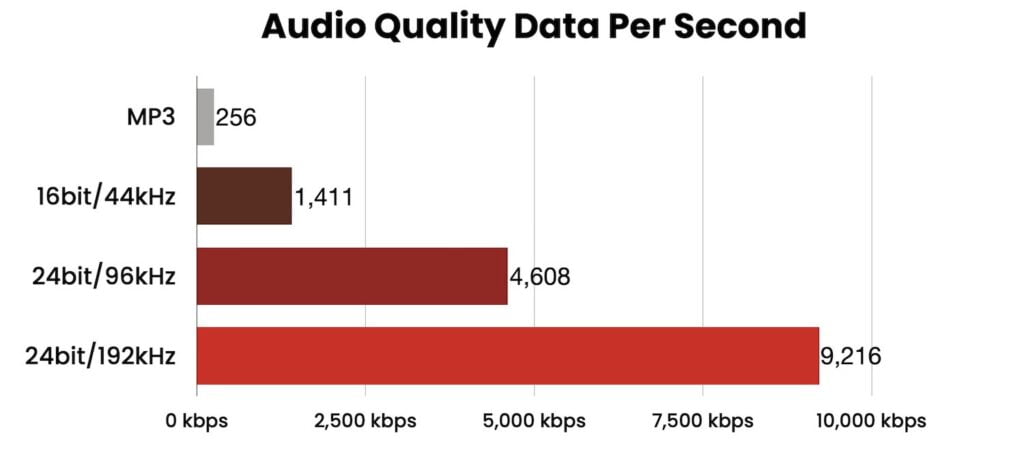In recent years, many big-name audio streaming services have introduced lossless audio options to their services. Many of us have been enjoying digital music for decades, so why do we suddenly need lossless music?
What Happened to Lossless Audio?

There was once a time when all music was lossless. Lossless refers to a certain level of sound quality that is uncompressed. This includes CDs and vinyl. Unfortunately, lossless audio takes up a decent amount of storage. Once everyone wanted to put their music collection in their pocket, the music had to be compressed (also known as lossy). Compressed audio was created to make music take up less space. Remember in 2010 when an iPhone came with 8GB of storage? Back then, storage came at a premium! Not to mention that the limited storage wasn’t only for music but also for your apps and pictures. To make music portable, the file sizes of music had to be small in size. Publishers made music small by decreasing the quality and with compression. The more compressed a song is and the lower the bitrate, the smaller the file size. Of course, things don’t get smaller without some data being removed. However, sophisticated compression algorithms such as MP3s were good enough for most casual listening that we couldn’t perceive the difference! Most people were listening through $30 headphones or the cheap speaker in their phone.
Now that phones come with so much more storage, space comes at less of a premium and music files can be larger. The lossless audio we hear about today refers to songs that are 16bit/44kHz or higher. These two parameters determine the quality of sound, also known as the bitrate and sample rate.
Bitrate: Defining a Sound
The bitrate is like the depth of the music. The higher the bitrate, the more data can be dedicated to defining a part of the sound. A great example of this is TVs when we made the jump from Full HD to 4K. 4K is four times the resolution of Full HD. Every four pixels in a 4K screen would be represented by a single pixel in Full HD. In this example, you could say that 4K is 4-bit and Full HD is 1-bit. They both show the same final image, but one is a more precise representation. Higher bitrate music can carry a more accurate representation of a sound.

Sample Rate: The Frame Rate of Audio
The sample rate is how many frequency samples are taken for each second of audio. a 20kHz sample rate has 20,000 individual sound definitions per second. Sound waves are made up of curves. The higher the frequency, the closer these curves are to each other. The closer they are, the higher the necessary sample rate. Imagine trying to draw an ocean wave with straight lines between four dots versus 2,000 dots: the 2,000 dots is probably going to look more round. You can’t capture the curvature of these high-frequency sound waves without a high-frequency sample rate. The higher notes on a piano can exceed 2,000hz, or 2kHz. That means the sound oscillates 2,000 times per second, or 2kHz. Now imagine you have another instrument at another frequency playing at the same time. To hear both instruments clearly, you need a higher sampling rate to capture the richness that a live performance would bring.
So What’s The Best Bitrate and Sample Rate?
So how high should the sample rate be? If you ask us, anything over 44kHz is great for most listeners, roughly double the human listening range. As discussed earlier, digital sound is composed of a bunch of single points of sound. When data points The human hearing range is roughly 20 Hertz to 20,000 Hertz (20kHz), so why do we say you want at least double this? To keep it simple, a digital sound clip is made up of a bunch of individual data points (the sample in the sample rate), when in actuality, sound is fluid – continuous. It has an infinite number of “individual points.” Imagine trying to draw a circle by drawing straight lines between eight dots versus 2,000 dots. That’s effectively what a sound clip has: a bunch of individual points. You make music when you have enough individual points to resemble a sound wave. Having a sample rate above the perceived human hearing frequency allows these individual points to sound like a fluid sound wave.
Where Can You Get Lossless Audio?
A lot of the big-name streaming services have recently adopted lossless audio. Apple Music, Amazon Music Unlimited (separate from Prime) and Tidal Hi-Fi can all put lossless audio into the palm of your hand. If you have our Sonos S2 home audio system, you can play any of these services throughout your home. Sonos S2 will play up to 24-bit 48kHz audio streams. Most listeners won’t be able to distinguish it from anything higher.
For those who crave the best home audio, a dedicated sound system outside of Sonos is your best bet. Talk to one of our SoundVision project specialists to discuss a system that can bring you the best audio system for you.



